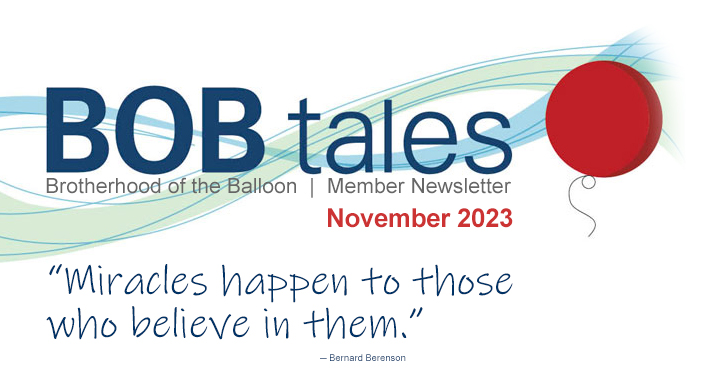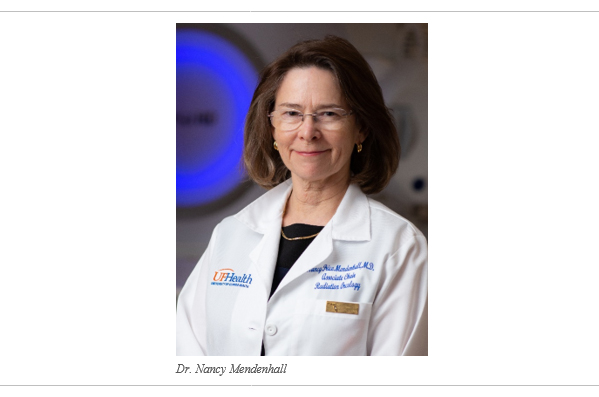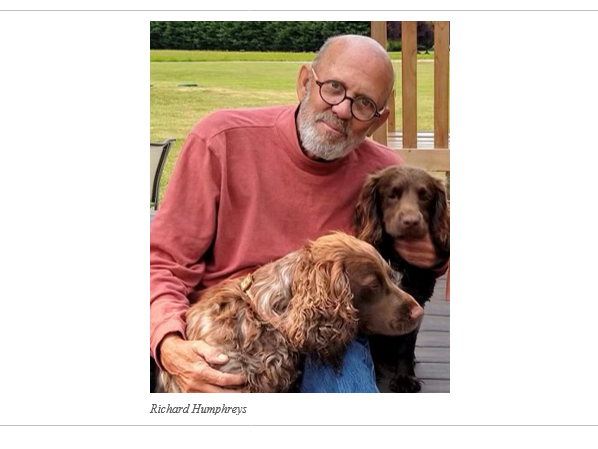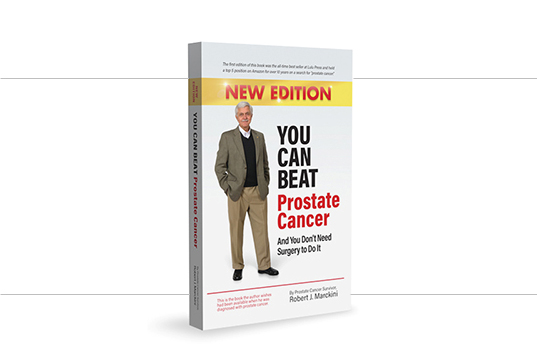
Dear Members (a note from Bob Marckini):
I remember writing in the opening memo to our newsletter about 10 years ago…
I have a request. I’ve always been a strong believer in the healing power of prayer. However, I find that now my own faith is being tested. Two months ago, my daughter Deb’s husband, Mark, was diagnosed with stage-4 metastatic pancreatic cancer. He’s currently undergoing chemotherapy (surgery was not an option) in Boston. We’ve been asking our family, friends, and acquaintances for their prayers. I’d also like to request prayers from you, our friends in the BOB. Please remember Mark, Deb, and their daughter, Gemma, in your prayers, asking for God’s healing, for His will to be done in their lives, and to help them through this most difficult time.
Our members responded splendidly with prayers and good wishes from all corners of the earth. One member – a pastor from the Midwest – asked his 100,000 followers on Twitter to pray for Mark. Friends who were affiliated with proton centers within the U.S. offered access to pancreatic oncology specialists. Help also came in many forms from close friends and neighbors. I could write a book on all that was done to support Mark, Deb, and their family during that incredibly difficult time. Surgery was out of the question; chemotherapy was their only option.
Mark’s chemotherapy lasted five months. After his last treatment, doctors were astonished when Mark’s CT scans showed no cancer. That’s right, not just a reduction in the number of tumors, but complete remission! Hundreds of tumors that had been there weeks before, had disappeared. His doctors, literally, had no explanation. The chemotherapy used was 25-year-old technology. No one expected the cancer to disappear completely, yet it did. Today, Mark is cancer free. July will mark 10 years in remission. What was the reason for this miraculous cure? The only explanation we have is the power of prayer.
I now have another prayer request. For the past couple of years, Deb has been suffering from a debilitating eye condition that is having a severe impact on the quality of her life. She experiences severe eye pain while driving and when spending long hours at the computer. She’s seen the best ophthalmologists and neurologists in the northeast; she’s had every eye test imaginable; she’s tried numerous medications and medical procedures; and none has helped. In the meantime, her condition, which is a form of small fiber neuropathy caused by an autoimmune disease, continues to progress. There’s one treatment that her doctors feel may help, but this intravenous immunoglobulin therapy is frightfully expensive, and her medical insurer refuses to cover it.
Once again, I’m asking for your prayers. They worked once and caused a miracle to happen; why shouldn’t we expect it to happen again? So, while Deb continues to pursue all medical options, we’d sure appreciate your prayers for her healing. I hope to be reporting another miracle in our family in the coming weeks and months. Thank you, and stay tuned.
![]()
As usual, we have another jam-packed newsletter this month with new information on the long-term effectiveness and toxicity of proton therapy for prostate cancer, an update on the COMPPARE trial which is evaluating the effectiveness of proton therapy vs. conventional X-ray radiation (IMRT) in treating prostate cancer (Deb and I are on the team helping to lead that trial); a new study which shows that combining new imaging technologies can aid in earlier detection of advanced prostate cancer; a continuation of a four-part “Flashback” series on male osteoporosis; a proven method (magic pill?) for boosting your health; avoiding one of the leading causes of Type-2 Diabetes; some surprising answers to last month’s brain teaser; new proton centers springing up in different parts of the world.
And, finally, with the open enrollment period upon us, there’s a major marketing effort underway by private medical insurers to convert patients from U.S. Government-run Medicare to one of the many, privately-run Medicare Advantage plans that promise numerous new benefits. We’re cautioning our members, once again, to examine these plans very carefully, as many have found in the past, to their surprise, they have lost important features and benefits that are provided in their government-run Medicare Plans.
As always, we welcome any suggestions you have on how to improve the value of the BOB Tales to our members. Please send your feedback to [email protected]. Bob Marckini
*To print the BOB Tales newsletter or view the newsletter with a larger font size, click here for the PDF file.

- New Research on Proton Therapy Long-Term Outcomes
- COMPPARE Study Update
- Combining PSMA PET/CT and MRI Imaging Finds Aggressive Cancers Early
- Buyer Beware – Medicare Open Enrollment is Underway
- Male Osteoporosis – Part II
- This Month’s Featured Member is a Funny Guy
- The Secret to Living a Richer Life
- Red Meat and Type-2 Diabetes
- Dark Chocolate Health Benefits
- 12 Answers to Last Month’s Brain Teaser

Proton Therapy for Prostate Cancer - New Research on Long-term Outcomes
Exciting new data on the long-term effectiveness and toxicity of proton therapy in patients with localized prostate cancer was recently released by researchers at MD Anderson. The study, published in The Green Journal, is the largest of its kind with the longest follow-up to date.
Lead author Steven Frank, MD, and colleagues from MD Anderson analyzed 2,772 patients who were treated from May 2006 through January 2020. Disease risk was categorized according to the National Comprehensive Cancer Network (NCCN) as low (640), favorable-intermediate (850), unfavorable-intermediate (851), high (315), or very high (116). The median patient age was 66 years, and the median follow-up time was seven years. Androgen deprivation therapy (ADT) was administered to 1,562 patients.
Overall, biochemical disease control was excellent, notably for patients with high risk or very high risk disease who historically have experienced poor outcomes even with aggressive treatments. Freedom from biochemical relapse, or recurrence, rates at five years and 10 years were 98 percent and 97 percent for the low-risk group; 98 percent and 94 percent for the favorable-intermediate group; 94 percent and 90 percent for the unfavorable-intermediate group; 94 percent and 85 percent for the high-risk group; and 86 percent and 69 percent for the very high-risk group. Overall gastrointestinal and genitourinary toxicity rates were low; patients with severe or life threatening side effects after five years was just 0.9 percent and at 10 years, 1.01 percent.
The research team at MD Anderson plans to present this data for inclusion within the NCCN Guidelines – a comprehensive set of recommendations for the prevention, diagnosis, and management of malignancies that apply to more than 97 percent of cancers affecting patients in the U.S. The guidelines are continually updated and revised to reflect new data and clinical information that may add to or alter current clinical practice standards.
The study, demonstrating the safety and efficacy of proton therapy for prostate cancer, will also allow for institutions to utilize the data to advocate for their patients.
COMPPARE Study: Proton vs. Photon for Prostate Cancer ─ More Differences in Patient Outcomes
In 2017, a research team led by Nancy Mendenhall, M.D., medical director of the UF Health Proton Therapy Institute in Jacksonville, FL, was awarded a five-year, $11.9 million grant from the Patient-Centered Outcomes Research Institute (PCORI) to directly compare the potential benefits and harms of proton therapy to standard radiation therapy when treating prostate cancer. COMPPARE was one of just 14 studies chosen through a highly competitive review process in which patients, caregivers, and other stakeholders joined scientists to evaluate proposals.

For COMPPARE, participants must complete questionnaires before treatment, three months after treatment, and then annually for at least three years. COMPPARE also collects participant PSA data and physician reported data from the 51 participating sites.
Enrollment of 2,524 patients – 600 randomized control trial proton participants, 900 pragmatic proton patients, and 1,024 photon participants – was completed Oct. 31, 2022. Immediately following enrollment completion, the team turned their focus to keeping patients actively involved in the study. Thus far, data collection rates have been excellent, according to Dr. Mendenhall.
“I am immensely grateful for the hard work and dedication of our study team, our partner organizations, and especially our participants. Going forward, we hope to continue to keep all enrolled patients actively involved in COMPPARE and to collect all outcome data at the appropriate time points. In doing so, we will have the best chance of understanding which type of radiation produces the best outcomes for patients,” Dr. Mendenhall said.
Just recently, Dr. Mendenhall reported that new information has emerged that suggests there may be more differences in outcomes between patients treated with photons and patients treated with protons, and that some differences may be related to underlying genetic variations. Follow-up surveys to participants will gauge their willingness to provide blood and saliva samples, which would enable the COMPPARE team to determine whether one type of radiation is better than the other for patients based on these genetic differences.
The COMPPARE team plans to apply for funding in 2024 that will make it possible to continue patient follow-up over an additional five years. Working together, these efforts will ultimately answer all pertinent outcome questions to guide treatment decisions for future prostate cancer patients, caregivers, their care teams, and insurance companies.
Another Valuable Use for PSMA/PET/CT Imaging
We’ve written extensively in the past about newer imaging tests that have greatly improved prostate cancer diagnoses. The relatively new Gallium 68 PSMA PET/CT scan has provided doctors with an incredibly valuable tool for diagnosing advanced, metastatic, and recurrent prostate cancer with great accuracy. This means patients with advanced disease can be diagnosed earlier and thus treated earlier, giving them a better chance of long-term survival.
State-of-the-art MRI imaging (3T-mp-MRI), another new tool has been of great value in identifying lesions within the prostate that should be targeted during biopsy.
Researchers in Central South University in Changsha, Hunan, China, have found that these two imaging tools used together can also help identify aggressive cancers that might otherwise be labeled clinically insignificant and not even biopsied, according to a recent article in Renal and Urology News.
On pages 230-231 in Bob’s book (new edition), he explains the terminology, PI-RADS, or Prostate Imaging Reporting And Data System. This is a score assigned to lesions identified within the prostate following a 3T-mp-MRI. This scoring system labels lesions from PI-RADS 1 to 5. If a lesion is rated PI-RADS 1, this means it’s highly unlikely that clinically significant cancer is present. At the other end of the scale, PI-RADS 5, means it’s highly likely that clinically significant cancer is present. Typically, doctors would recommend a biopsy for patients with PI-RADS scores of 4 or 5. Patients with scores of 1, 2 or 3 are often encouraged to do active surveillance.
Researchers in Hunan, China, have been reexamining PI-RADS 3 patients, where the score suggests “uncertainty as to whether clinically significant cancer is present,” and they have found that when taking other factors into consideration, a surprising number of patients in this category have clinically significant disease and should be biopsied and treated. These other factors include prostate volume, lower free-PSA to total PSA ratio, higher PSA levels, higher PSA density and more. Taking all these factors into consideration, these researchers have concluded that it is reasonable to perform biopsies in men with PI-RADS 3 lesions when they have positive PSMA PET/CT findings.
Medicare Open Enrollment is Underway – Buyer Beware
We’ve written about this a few times in the past, and we want to warn our members that, while there are some benefits to switching to a privately managed Medicare Advantage plan, there can also be some significant drawbacks. Nearly half of eligible Medicare beneficiaries are enrolled in Medicare Advantage Plans, twice as many as five years ago.
As a reminder, Medicare Advantage plans are run by for-profit private enterprises. These plans are heavily marketed, and many are lured into joining them to gain new benefits such as eye glass and dental coverage. No small number of seniors later learn that some of their medications are no longer covered, they can no longer see certain doctors, and some previously allowed medical treatments are no longer covered by their new Medicare Advantage plans. Proton therapy is one of the best examples of the latter.
We suggest you re-read articles on this subject in our December 2022, February 2023, and May 2023 issues. Contact Deb Hickey at [email protected] if you have any problems accessing the PDFs we’ve linked to here.
The current open enrollment period, also known as “The Medicare Advantage and Prescription Drug Plan Annual Election Period,” runs from October 15 through Dec. 7, 2023

We’ve been producing BOB Tales newsletters for more than 22 years. During this time we’ve published articles that many new members haven’t seen, and some older members may have forgotten. So, we periodically re-run articles from past BOB Tales. The following important article, from July 2007, is the first in a four-part series written by a prominent and learned member of our group. It’s a topic all our members should pay close attention to. This series, published 16 years ago, is as timely today as it was then.
Male Osteoporosis: A Four-Part Series
Last month, BOB Member Dr. Herbert Klein presented Part I of a multi-part series on male osteoporosis. The more Herb researches the subject the more he learns and the more he wants to pass on to his “brothers.” All men (and women) should pay attention to bone health, especially as we get older, but prostate cancer survivors should pay even closer attention to osteoporosis and vitamin D as Herb explains. Following is part II:
The following piece was written by Dr. Herbert Klein.
Part II
In Part I, I called your attention to the “silent epidemic” of osteoporosis in older men, both with and without prostate cancer, but I mentioned some disagreements pertaining to the publication that I had used as a source.
The stated target serum level for 25 hydroxyvitamin D was at least 32 ng/mL and that is the basis of the second disagreement.
Now it would be wrong to create the impression that vitamin D is a sure cure for osteoporosis – other medications may be needed. However, let me say at this point that I am very much impressed with the importance of this substance, because (a) low vitamin D levels are widespread, (b) vitamin D is critical to bone strength, and (c) of special importance to our brotherhood, there is evidence that vitamin D fights prostate cancer and has numerous other health benefits as well. That said, the vitamin D story reminds me how often what is claimed to be good for your prostate cancer is good for you anyway. Omega-3 fatty acids come to mind, as well as keeping a healthy weight –but I am straying from the subject.
Before dealing with the disagreement, I would like to tell you some fundamentals about this important substance. I think you will be hearing more about it (as I will also explain later) and would do well to be prepared to understand it. I will get a little technical, in terms of biochemistry, but I ask you to bear with me.
In an article by Dr. Donald Trump (BOB Comment 11/23: No relation) in the Prostate Cancer Communication Newsletter (no longer available), he wrote about the major players in the context of the biochemical reactions of vitamin D, together with synonyms and important facts.
Vitamin D Made Easy
7-dehydrocholesterol
(a natural substance)
→reaction in skin requiring sunlight→
Vitamin D3
(cholecalciferol, the recommended supplement, available over-the-counter)
→reaction in liver→
25 hydroxyvitamin D3
(calcidiol, 25(OH)D3, 25-hydroxycholecalciferol, the best serum measurement)
→reaction in kidneys→
1, 25 dihydroxyvitamin D3
(calcitriol, 1,25(OH)2D3, 1,25-dihydroxycholecalciferol, the biologically active substance and likely the major cancer-fighter, available as a prescription medication)
There are two to four synonyms for each form of vitamin D3! Ouch! And to further aid your reading, you should also know that different units of measurement are used by different writers. Thus, for vitamin D3, 40 IU is the same as 1 microgram (μg); and for 25 hydroxyvitamin D3, 1 ng/mL is the same as 2.5 nanomoles per liter (nmol/L).
Now that all that’s clear, along comes a wild card, vitamin D2, also known as ergocalciferol. According to the Vitamin D Council, it’s a “vitamin D-like, patented drug that is not naturally present in the human body. It’s derived from fungal and plant sources by activating ergosterol with ultraviolet light. It’s only half as potent as cholecalciferol (real vitamin D) and may even block some of cholecalciferol’s beneficial effects. It’s more toxic and is the cause of most of the reported cases of vitamin D toxicity.” Nonetheless, it’s on the shelf at my local nutrition supplement store and has been the form of the vitamin in some fortified foods. Analogous to vitamin D3, the forms 25 hydroxy vitamin D2 and 1, 25 dihydroxyvitamin D2 exist, but overall, the biochemical reactions of vitamin D2 are different from vitamin D3.
In the first installment, I may have added to the confusion by talking about measurements of 25 hydroxyvitamin D, without a numerical subscript. Strictly speaking, when names include only the “D”, they can refer to both D2 and D3. There’s likely some inconsistency about this. When I had my serum 25 hydroxyvitamin D measured, the levels of 25 hydroxyvitamin D2 and 25 hydroxyvitamin D3 were each reported. Other labs may handle this differently.
Because of the above points, it may be wise to stick with vitamin D3 for use as a supplement and to avoid vitamin D2. Because I had been doing that, my 25 hydroxyvitamin D2 level was undetectable. I should add though, that vitamin D2 has the basic desired effects of a vitamin D supplement, and may be preferred by some folks on the basis of their dietary principles, because the standard method of manufacturing vitamin D3 is from animal sources (specifically sheep’s wool lanolin).
Now you have a guide to any reading that you may choose to do about vitamin D. In the next installment, I’ll explain the disagreement and tell you why you may be hearing more.
Featured Member: Actor/Comedian/Writer, ‘Chilli’
We have a celebrity in our midst! BOB member James “Chilli” Chillingworth is an actor, stand-up comedian, and writer. Since he started performing just about 10 years ago, Chilli has accomplished a substantial amount, including over 100 IMDB (Internet Movie Database) credits and more than 180 shoots of various types (movies, TV shows, commercials, web series, music videos, print ads, and short films).
Chilli is also the founder and CEO of The Consulting Practice, a cybersecurity and IT consulting company.

Born in Toronto, Canada, Chilli always had a passion for performing. Although he started doing magic shows for family and friends as a child, it wasn’t until his early 50s that Chilli took his talent outside the comfort of his own home. Take a look at one of his first “gigs” in a public service announcement on the dangers of sun exposure.
In 2016, Chilli moved to San Francisco, CA, for a cybersecurity job. Soon thereafter, he transferred to Los Angeles. While in LA, he took some comedy writing classes, and appeared in a few acting gigs.
About a year after moving to LA, Chilli was informed by his local doctor that his PSA was rising. Three years later in early 2020, his doctor suggested it may be time to get an ultrasound and biopsy. To make matters worse, the Covid-19 pandemic was just beginning. So, Chilli decided to return to Toronto to be with family and visit his primary care physician for more testing.
Chilli was shocked when he was diagnosed with intermediate-stage prostate cancer. A urologist recommended he get a bone scan and a CT scan of his chest, stomach and hips. “Thankfully, all of those tests came back negative,” Chilli said. “But, I was really apprehensive about what to do for treatment because my doctor wasn’t really proactive in recommending a clear treatment plan.”
At this point, it was November 2020, and Chilli felt compelled do his own research on the available treatment options. “I wanted something non-invasive,” Chilli said. “And then I found information about this proton radiation treatment that could kill the cancer without damaging surrounding tissues and organs. I was excited about it!” But Chilli quickly learned there weren’t any proton therapy treatment centers in Canada.
Disheartened, Chilli continued his research, this time looking into proton therapy facilities in the U.S. “I found Loma Linda Cancer Center in southern California,” he said. “And they’d been around for decades, so I thought they’d have a lot of experience.”
After making a phone call to LLUCC, Chilli received a package of information which included Bob Marckini’s book. “I read it as soon as I got it,” Chilli said. Then, after discussing proton therapy with his son and daughter, Chilli decided to have proton therapy.

Chilli began treatment a few weeks later. Unfortunately, because of the pandemic, he didn’t get “the full treatment experience” in that he wasn’t able to take part in any patient activities like weekly meetings and restaurant outings. He didn’t get to work out in the fitness center or swim in the pool. And, he didn’t get the opportunity to visit any nearby landmarks. “Because of my potentially immuno-compromised condition, I didn’t really go anywhere other than my hotel room,” Chilli said. He even spent Christmas, New Years, and his birthday alone.
To make matters worse, Chilli was receiving hormonal therapy due to the aggressiveness of his cancer, so he was experiencing some unpleasant side effects. “But, my doctor at LLUCC recommended daily exercise, so I did some Internet fitness videos and that helped,” Chilli said. He also found video calls with friends and family – as well as work colleagues – also helped to “take the edge off of things.”
Overall, Chilli said his treatment experience was good. Talking with patients through face masks in the waiting room helped with the loneliness. Chilli also considers himself to be a positive and “generally happy” person. “I do self hypnosis,” Chilli said. “The power of the mind is amazing.”
After treatment, Chilli moved back to Toronto, though he travels back and forth to LA often for work and acting opportunities. He stays in shape by playing soccer, hockey, team handball, basketball, and rowing. Chilli also “hits the gym” regularly. “I feel really fit and my PSA readings are low,” he said. “And any side effects I had from the hormone treatment are gone.”
Chilli feels he truly lives life to the fullest. In addition to working in cybersecurity, he also volunteers for cybersecurity events and speaking engagements. He acts as much as he can and continues to do stand-up comedy. “Best of all, I visit my family regularly,” Chilli said. “I love to spend time with my two grandsons. We laugh our heads off when we watch Bugs Bunny, Road Runner, and Wile E. Coyote.”
“Overall life is great and I’m so grateful for the treatment I received at Loma Linda and to Bob Marckini for writing his book,” Chilli said.
View Chilli’s IMDB page for more information and links to his acting videos.

‘My husband has prostate cancer and I’d like to talk with spouses of former patients…’
Last month, we asked for members who were recently treated with proton therapy – those treated after 2020 – to volunteer to communicate, via email or phone, with newly diagnosed men. We asked you to share your experiences of treatment and life after treatment with men who have questions about proton therapy versus the other treatment options – men who are confused and/or frightened about side effects, recurrence rates, and overall quality of life. We also asked specifically for members with Parkinson’s disease to step forward and volunteer to speak with newly diagnosed men who have the same neurological condition. We were overwhelmed with hundreds of responses and we appreciate every single one. Thank you.
The newly diagnosed men, and sometimes their significant others or other family members, who contact us are doing their due diligence. They’re in the midst of researching treatment options and want the “nitty gritty” truth about treatment protocol, side effects, and life after treatment. They want to connect with others who’ve been in their shoes. If they’re considering a specific proton center, they want to know about treatment planning and set-up, travel and lodging options, on-campus activities and social events; where to eat out and where to work out. If they have high Gleason scores, they often want to speak with others who had high Gleason scores to learn about the benefits and potential side effects of hormonal therapy. If they have preexisting health conditions, they want to speak with others who had the same or similar preexisting health conditions before treatment. Some want to connect with others in their hometown. Some are interested in speaking with men who share the same career or those who traveled far for their treatment. Some had failed surgery and want to speak with men who had proton therapy after experiencing a recurrence following a radical prostatectomy. Most recently, we had a spouse of a newly diagnosed man who asked to speak with other spouses of men who’ve gone through treatment.
If you’re a spouse – or significant other – of a former prostate cancer proton therapy patient and you’re willing to share your experience alongside your husband or partner, please send an email to [email protected]. You can specify whether you prefer email contact, a phone call, or both. Thank you!
A Time of Thanksgiving
This is the time of year when most of us reflect on all the blessings in our lives. It’s also the time many of us make our year-end gifts to the charities we believe are most deserving of our financial support. Among our favorites, and those that we give to annually are St. Jude’s Children’s Research Hospital, the Red Cross, the Salvation Army, the American Cancer Society, the Tunnel to Towers Foundation and, of course, the institution that made our prostate cancer treatment possible, Loma Linda University Health (LLUH).
Each month, we receive a list of names of our members who make gifts to LLUH, and we make every effort to contact each in order to express our thanks. Many of our calls go unanswered, we suspect, because of all the spam calls people receive. Nevertheless, we keep trying.
This year, Loma Linda University Health’s funding needs are even greater than in the past. Just as they did 35 years ago when they made a major investment in proton therapy, they are making a huge investment in theranostics, an incredibly novel technology for treating a wide array of cancers at advanced and metastatic stages. Theranostics has proven its value – even its early stages at LLUH – in treating several prostate cancer patients recently, whose advanced, metastatic cancers had reached the stage where other treatments could not help.
In the case of Richard Humphreys – who we’ve written about in the past – his prostate cancer had spread throughout his body, and he had practically no hope of making it to the end of the year. That was more than two years ago. Richard came to us through a friend, and we introduced him to Dr. Frankis Almaguel at Loma Linda University Health, who is leading the theranostics program there. Today, Richard’s PET/CT scans – which initially showed more than 100 lesions – are essentially clear. And he’s one happy camper.

LLUH is currently making a major commitment to investing in this new technology along with additional transformational cancer treatment advances we look forward to sharing with you in future newsletters. They’ve started hiring nuclear research scientists and physicians with plans to construct a state-of-the-art theranostics research and treatment center at their university and medical center campus. They will soon be investing in multiple cyclotrons and other equipment to produce new radionuclides for treating numerous cancers, And that’s just the beginning. The ultimate cost will be orders of magnitude greater than their investment in proton therapy.
And, while they are seeking multiple funding sources, one key component of this funding effort is philanthropy – they need our help. So, we are asking our members to please keep LLUH and their new theranostics program in mind when making your year-end charitable gifts. There are thousands more patients like Richard Humphreys – maybe even members of your own families – who will one day benefit from theranostics treatment at Loma Linda University Health.

Giving Options
- Online: Donate here. From the pull-down menu, choose where you’d like to direct your gift — 1) Proton Research through the James M. Slater Chair, 2) Proton Research through the Robert J. Marckini Chair, or 3) choose “Other” and specify “Cancer Center Vision” or another area where you’d like your gift directed in the space provided.
- By Check: Make your check out to “LLUCC.” Specify where you’d like to direct your gift in the memo line — 1) Slater Chair, 2) Marckini Chair, 3) Cancer Center Vision or 4) write “unrestricted” so LLUH can use it where it’s needed most. Mail your check to: LLUH, Office of Philanthropy P.O. Box 2000, Loma Linda, CA 92354.
- By Phone: Call Regina Joseph at 909-558-5010.

The Secret to Living a Richer Life
Alexander Green, chief investment strategist from The Oxford Club wrote:
Imagine a pill that helps you lose weight, exchanges fat for muscle, strengthens your bones, fortifies your immune system, prevents heart disease, cancer, and stroke, relieves stress, improves your mood, helps you sleep, boosts your brainpower, keeps you looking younger, and significantly extends your life. You can stop imagining now. There isn’t any such pill. (If there were, I’m sure you’d have heard about it.) But the good news is you can get this whole smorgasbord of benefits – and more –from about a half-hour of daily exercise.
After whetting your appetite in an article in The Oxford Club, an independent financial research publisher and a private network of investors and entrepreneurs, Green tells us there isn’t any such pill. But he explains the benefits of exercise.
This isn’t breaking news. You’ve read it here before. But Green’s point is that researchers are discovering that exercise is far more beneficial than we ever realized. And conversely, a sedentary lifestyle is far more dangerous than we ever thought.
The Centers for Disease Control and Prevention (CDC) reported on a survey from close to a half-million adults in the U.S., which concluded that 80 percent of Americans are setting themselves up for serious health problems because they fall far short of the recommended amounts of exercise, which is “fueling a national healthcare crisis.”
Health experts tell us that exercise slows and even reverses muscle loss, weight gain, artery hardening and joint stiffening as well as reducing your risk of dementia by half and lowering your odds of being diagnosed with Alzheimer’s disease by 60 percent. Exercise helps prevent or reverse diabetes, high blood pressure, heart problems arthritis and even macular degeneration.
People who exercise are also smarter, outperforming non-exercisers in reasoning, attention, long-term memory and problem-solving. They are also less likely to suffer from anxiety and depression.
One of the world’s leading cancer researchers, Dr. David B. Agus, writes:
There are 100 billion neurons in each of our brains, and they love a good physical workout. Studies show that older people who still do vigorous exercise, play competitive sports, or just walk several times a week protect their brains’ white matter from shrinking.
Dr. Joel Wade, a psychologist and life coach said, “When I have a client who’s feeling down, the first thing I tell him or her to do is get outside and get moving.”
Anthropologists tell us that our ancestors used to walk as much as 12 miles each day, probably looking for food and evading predators.
Whatever the reason, most of us don’t get enough exercise, which our bodies and our brains crave.
Green points out that even if you can’t reach the 30 minute-per-day goal, you’ll achieve significant benefits from as little as 20 minutes per day of exercise, including, and especially, extending your life.
The Department of Health and Human Services tells us that every bit of exercise helps, and they’ve published national exercise guidelines:
- 150 minutes of moderate aerobic activity each week, such as brisk walking or lap swimming
- 75 minutes a week of more vigorous aerobic activity, such as running
- Weight training at least twice a week, to ensure both bones and muscles are healthy
In summary, exercise is one of the most important things we can do to prevent or reverse a broad range of diseases. If you combine exercise with a healthful diet – especially a whole-food, plant-based diet – you can dramatically improve the quality of your life as well as the length of your life.
Maybe there really is a magic pill out there. It’s called “exercise.”
Red Meat Tied to Higher Risk of Type 2 Diabetes
A new study found that consumption of red meat – including processed and unprocessed red meat – was strongly linked to an increased risk of Type 2 diabetes. Study participants who ate the most meat had a 62 percent higher risk of developing Type 2 diabetes compared to those who ate the least. Every additional daily serving of processed red meat was linked to a 46 percent greater risk of developing Type 2 diabetes, and every additional daily serving of unprocessed red meat was associated with a 24 percent greater risk.
The researchers also found that replacing red meat with healthful plant-based protein sources, such as nuts or legumes, or modest amounts of dairy was tied with a lower risk of Type 2 diabetes.
For the study, researchers analyzed health data from 216,695 participants from the Nurses’ Health Study (NHS), NHS II, and Health Professionals Follow-up Study. The participants were given questionnaires about their diet in food frequency every two to four years, for up to 36 years. During this time, more than 22,000 of them developed Type 2 diabetes.
“Our findings strongly support dietary guidelines that recommend limiting the consumption of red meat, and this applies to both processed and unprocessed red meat,” said lead author Xiao Gu, postdoctoral research fellow at Harvard T.H. Chan School of Public Health.
Type 2 diabetes is a major risk factor for cardiovascular and kidney disease, cancer, and dementia.
While previous studies have found a link between red meat consumption and Type 2 diabetes risk, this study adds a greater level of certainty about the association.
8 Health Benefits of Dark Chocolate

Is dark chocolate good for you?! We’re happy to tell you that – yes – scientific studies have shown that moderate consumption of dark chocolate can actually have enormous health benefits. Eight of them are listed below.
- Dark chocolate may help prevent heart disease and lower the risk of stroke. The phytonutrients, called flavonoids, in dark chocolate help produce nitric oxide, which causes blood vessels to relax and blood pressure to lower.
- Dark chocolate makes you smarter. Eating 70 percent cacao chocolate increases neuroplasticity, the brain’s ability to form new synaptic connections. This could have positive effects on memory, cognition, and mood. Furthermore, the flavonoids in dark chocolate enhance memory and learning as they tend to accumulate in areas of the brain responsible for those functions.
- Dark chocolate could reduce the risk of developing diabetes. Moderate consumption of dark chocolate rich in cacao could improve how the body metabolizes glucose. The flavonoids in dark chocolate were found to reduce oxidative stress, which scientists believe is the main cause of insulin resistance. By improving the body’s sensitivity to insulin, resistance is reduced, and therefore the risk of developing diabetes decreases.
- Dark chocolate improves gut health and may help with weight loss. In his book called Eat Chocolate, Lose Weight, Neuroscientist Will Clower, PhD, says “eating a bit of dark chocolate before or after meals triggers hormones that signal to the brain that you’re full.” Research has also shown that during digestion, dark chocolate acts like a prebiotic, a type of fiber that promotes the growth of “good” bacteria in the gut.
- Dark chocolate may decrease the risk of developing cancer. Eating a diet rich in flavonoids can help prevent cell damage, which often precedes a cancer diagnosis. Epicatechin – one of the many flavonoids in dark chocolate – is believed to be responsible for its cancer-fighting properties. Dark chocolate also contains magnesium. Research has shown that immune cells in the body can target abnormal or infected cells only in a magnesium-rich environment.
- Dark chocolate is good for your skin. Dark chocolate contains manganese, a mineral that supports the production of collagen. Also, the high levels of antioxidants in dark chocolate may protect the skin from ultraviolet rays.
- Dark chocolate lowers your cholesterol. The polyphenols in dark chocolate may help lower some forms of “bad” LDL cholesterol when combined with other foods like almonds and cocoa.
- Dark chocolate gives you energy and makes you happy.Dark chocolate contains theobromine, which, similar to caffeine, can cause a boost in energy and enhance your mood. Dark chocolate contains neurochemicals, such as serotonin, the body’s natural “feel good” chemical, which regulates mood.
“The darker you go, the more antioxidants you’ll get, but there needs to be a balance between eating palatable dark chocolate and getting the health benefits,” says Toby Amidor, RD, a cookbook author and nutrition expert for Food Network.
According to health experts, the best option is choosing a bar with 70 percent cacao or higher. Chocolate bars with lower percentages of cacao have more added sugar and unhealthful fats. It’s important to remember that even though dark chocolate is a better choice than milk chocolate, it’s still chocolate, which can be high in calories and saturated fat. Amidor recommends eating no more than 1 ounce of dark chocolate per day.
► BOB Comment: This article on the health benefits of dark chocolate was inspired by a BOB member who sent us an email following last month’s newsletter. He wrote, “I especially like the report in your health section on foods that give you energy. But, I was hoping I’d find dark chocolate on that list. Darn!” Well, Bernie, now you can feel free to grab a Godiva Signature 72 percent cacao dark chocolate bar!

You Can Beat Prostate Cancer: And You Don't Need Surgery to Do It – Second Edition
Amazon Ranking and Reviews
Bob’s book is still No. 2 on Amazon’s list of more than 6,000 books on a search for “prostate cancer.” There are 230 reader reviews – most with a five-star rating.
Below is an excerpt from a review by “Rodriguez.”
![]()
Bob’s book was my map to successful proton therapy at Loma Linda University Cancer Center in 2016/2017. I highly recommend all those with prostate cancer to read it.
LLUCC was extremely helpful in finding my wife and me an apartment. We were also able to use their gym and pool; and we played golf at the Redlands golf course. LLUCC has a Wednesday night meeting and dinners out for patients. And, I’ve had zero side effects! Thanks, Bob, for your book. I’ve passed it on to two friends. One had successful proton treatment at the Texas Center in Dallas.
Was Bob's Book Helpful to You?
If Bob’s book was helpful to you and you’d like to help others find it on Amazon, please write a review. Book reviews help boost the book’s visibility within Amazon’s search results for users looking for information on prostate cancer treatments and/or proton therapy.
Proceeds from book sales are used to help fund our efforts and to support proton therapy research.

Last Month’s Brain Teaser
Using each of the digits 1, 2, 3, 4, 5, 6, 7, 8, 9 once and only once, form two whole numbers, one of which is double the other.
Answer:
We told you this was a difficult one! In fact, it was so difficult, there were several different answers that came in from our members. And the difference in the types of answers told us we should have worded the teaser more clearly. We were looking for two numbers – one with four digits and one with five digits. But we’ll get to that in a minute.
Some of you submitted answers like this:
7+8 = 15
1+2+3+4+5+6+9 = 30
And this:
9+8+7+6 = 30
5+4+3+2+1 = 15
One member submitted this:
123,456,789 and 246,913,578
Brilliant! But these and all the other entries didn’t meet all the criteria: a) using each of the digits only once, and b) forming two whole numbers (out of the 9 digits), one of which is double the other.
Once you apply those rules, you’ll discover there were 12 possible correct answers!
6,729 and 13,458
6,792 and 13,584
6,927 and 13,854
7,269 and 14,538
7,293 and 14,586
7,329 and 14,658
7,692 and 15,384
7,923 and 15,846
7,932 and 15,864
9,267 and 18,534
9,273 and 18,546
9,327 and 18,654
Winner:
The lucky winner with the answer, “7,692 and 15,384,” is Christian Brown, the spouse of BOB member, Bill Brown. She sent us a touching email and we’ve included an excerpt below.

We will be so thankful to receive a copy of Bob’s second edition book and will treasure his signature. His book saved us! When Bill was first diagnosed, we went into research mode and scoured the Internet. I was burning the midnight oil every night, searching for the best treatment, trying to sort through all the (non-parallel) research studies, and differing reporting protocols, and trying to learn about all the things that were so new to us, and yet so vital to understand.
And yet try as I might to sort through all the inconsistencies and variables, the more I sought to understand the divergent treatment approaches, the more complex and unknowable it all seemed. Despite faithful prayer, frustration became my constant companion. This was my darling husband’s life and happiness we were dealing with, and the research results were a mess and a minefield!
When we found Bob’s book, I read every word of it, and re-read most of it to Bill, and we knew we’d been guided to God’s answer for Bill’s life. We traveled from Northern to Southern California, rented an apartment, entered treatment at Loma Linda, and have been blessed beyond our dreams by the experience there …
... Deb, what you do with the newsletter (and all aspects of the Brotherhood of the Balloon) is invaluable. You and Bob are truly making a difference in this world, and in the precious lives you help every day. Thank you so very much. You are truly doing the Lord’s work.
Thanks also, for the lighthearted tidbits at the end of the newsletter, and for the “Funnies.” You make us all smarter and feel better, as you’re moving the world forward. And you are doing all of that with an earnest and profound purpose, and a special sparkle that is charming, and contagious!
God bless you,
Christian Brown

New Brain Teaser
This one is a bit easier (only a bit).
Ignoring the area code, a little boy’s phone number is 741-5963. He’s able to remember it by thinking of just one letter in the alphabet. Which letter?
Send your brain teaser answer to [email protected] for a chance to win a signed copy of Bob Marckini’s NEW second edition book, You Can Beat Prostate Cancer.

Six Things to Ponder…
- If a bottle of poison reaches its expiration date, is it more poisonous or is it no longer poisonous?
- Which letter is silent in the word “Scent” – the S or the C?
- Do twins ever realize that one of them was unplanned?
- Every time you clean something, you just make something else dirty.
- The word “swims” upside-down is still “swims.”
- Over 100 years ago, everyone owned a horse and only the rich had cars. Today everyone has cars and only the rich own horses.

Did I read that sign right?
Notice in health food shop window:
CLOSED DUE TO ILLNESS
Spotted in a safari park:
ELEPHANTS, PLEASE STAY IN YOUR CAR
Seen during a conference:
FOR ANYONE WHO HAS CHILDREN AND DOESN’T KNOW IT, THERE IS A DAYCARE ON THE 1ST FLOOR.
Sign in a farmer’s field:
THE FARMER ALLOWS WALKERS TO CROSS THE FIELD FOR FREE, BUT THE BULL CHARGES
Message in a leaflet:
IF YOU CAN’T READ, THIS LEAFLET WILL TELL YOU HOW TO GET LESSONS.
Sign on a repair shop door:
WE CAN REPAIR ANYTHING (PLEASE KNOCK HARD ON DOOR - BELL DOESN’T WORK)

More Funnies…
Auto-Correction: My wife was at a department store, and she texted me a selfie in a new dress. She asked, “Does this make my butt look big?” I texted back, “Noo!” My phone autocorrected my response to “Moo!” Please send help!
Road Sign: A road sign read, “Red Squirrels Drive Slowly.” To be honest, I’m surprised they can drive at all.
Childhood Home: I went by the house I grew up in and asked if I could go in and look around. They said, “No!” and slammed the door. My parents can be so rude!

Did You Know ...
- We are more creative in the shower. Researchers believe that’s because warm water increases the flow of dopamine and makes us more creative.
- Froot Loops are all the same flavor, despite their different colors. What a disappointment to Froot Loop lovers!
- The first airplane flight was on Dec. 17, 1903. It was the first of four flights that day by Wilbur and Orville Wright. That first flight lasted just 12 seconds and traveled only 180 feet.
- Supermarket apples can be a year old! Farmers often pick apples in the fall, cover them in wax, hot air dry them, and then put them in cold storage. This keeps them edible and ready to sell for six to 12 months.
- Venus is the only planet in our solar system that rotates clockwise. The other seven spin counterclockwise: Mercury, Venus, Earth, Mars, Jupiter, Saturn, Uranus, and Neptune.

It’s Football Season: Some Quotes to Ponder…

It isn’t necessary to see a good tackle, you can hear it!
─ Knute Rockne, Notre Dame
When you win, nothing hurts.
─ Joe Namath, Alabama
In Alabama, an atheist is someone who doesn’t believe in Bear Bryant.
─ Wally Butts, Georgia
I never graduated from Iowa. But I was only there for two terms – Truman’s and Eisenhower’s.
─ Alex Karras, Iowa
My advice to defensive players is to take the shortest route to the ball and arrive in a bad humor.
─ Bowden Wyatt, Tennessee
I could have been a Rhodes Scholar except for my grades.
─ Duffy Daugherty, Michigan State
Always remember Goliath was a 40-point favorite over David.
─ Shug Jordan, Auburn
I asked Darrell Royal, the coach of the Texas Longhorns, why he didn’t recruit me. He said, ‘Well, Walt, we took a look at you, and you weren’t any good.’
─ Walt Garrison, Oklahoma State/Dallas Cowboys
Son, you’ve got a good engine, but your hands aren’t on the steering wheel.
─ Bobby Bowden, Florida State
Football is NOT a contact sport, it is a collision sport. Dancing is a contact sport.
─ Duffy Daugherty, Michigan State
If lessons are learned in defeat, our team is getting a great education.
─ Murray Warmath, Minnesota
We didn’t tackle well today, but we made up for it by not blocking.
─ John McKay, USC
I’ve found that prayers work best when you have big players.
─ Knute Rockne, Notre Dame

Thank You
We couldn’t close this Thanksgiving issue without giving thanks to the people and organizations that help us with our mission. Without you, this “ministry” wouldn’t exist.
Thank you, our members, for your devotion to “the cause,” for sharing with others your knowledge and passion for proton therapy; for the constant feedback and messages of gratitude; for the news stories and information you think may be of interest to us and to others; for all the questions you ask on behalf of family members and others; for those who have volunteered to help newly diagnosed men and their family members who haven’t found their way; for the You Can Beat Prostate Cancer books you buy in bulk and your offer to pass them along to others; for forwarding the newsletter to those who may find it valuable; and for your ongoing generosity through gifts for proton research.
Thank you to the late Dr. James M. Slater, Dr. Jerry Slater, and Loma Linda University Cancer Center, for pioneering proton therapy for prostate cancer and other diseases 30-plus years ago so that tens of thousands could have their cancers cured and the quality of their lives preserved. Thank you also for your support of the Brotherhood of the Balloon, your encouragement, and your unwavering faith in our mission.
Thank you, LLUCC senior management, for your support of our efforts in so many ways.
Thank you, all the proton centers, for acknowledging the significant benefits of proton therapy, for making the capital investment to build 43 proton centers in the U.S. and for enabling thousands more patients to benefit from this technology.
Thank you, Jennifer Maggiore, JJ Vitale, and the National Association for Proton Therapy, for building awareness and educating others about proton therapy; for your support of our organization; and for being a valuable resource.
Thank you, Dr. Nancy Mendenhall at the University of Florida Health Proton Therapy Institute, for tirelessly leading the effort on the COMPPARE trial comparing proton therapy to IMRT for prostate cancer. Thank you also to the stakeholders, physicians, scientists, statisticians, advisers, and patients, for making this study possible.
Thank you, Dr. Steven Frank at MD Anderson for your determination and steadfast commitment to studying the long-term effectiveness of and toxicity of proton therapy in patients with localized prostate cancer and creating the largest study of its kind so the proton community can use the data for patient advocacy.
Thank you, all the physicians and administrative people connected with proton therapy, for routinely making yourselves available to us when we need answers to technical questions, information for our newsletters, or support for patients in need.
Thank you, Attorney Tim Rozelle, and the members of the Proton Therapy Law Coalition, for helping to coordinate and unify proton therapy providers, patient advocates, and attorneys to fight health insurance denials of proton therapy.
Thank you, Attorney Doug Terry and Dr. Andrew Chang at CA Protons, for your extraordinary partnership and commitment to patients who’ve been treated unfairly by their insurance companies.
Thank you, Bob Hawley, for your timely, careful, and professional reviews of our monthly newsletter.
Thank you, LLUCC Web team, for updating and redesigning our website and ensuring all of our systems are running smoothly and for answering our many questions with careful thought and timeliness.
Thank you, Larry Becker, Kelsey Culler, and the rest of the LLUCC marketing, PR, and legal team, for the thorough and timely editorial reviews of our monthly newsletter.
Thank you, Rathyna Gomer and many others at LLUCC, for supporting our daily activities and for your responsiveness when obstacles surface.
And finally, although he’s retired from LLUH and now pastoring a church in Los Alamitos, CA, we would be remiss if we didn’t extend a special thank you to Dr. J. Lynn Martell, who recognized the extraordinary potential of our group at the very beginning and offered encouragement and support in so many ways over the years. We wouldn’t be here today if it weren’t for Lynn and his support.
![]()
With the help of these people, we’re making a difference: Our members are well informed ambassadors for proton therapy; our group is responsible for introducing hundreds of men each year to proton therapy; and we have responded to assaults and misinformation on proton therapy as well as attempts by some insurers to stop reimbursing for proton treatment. Through our members, we have raised more than $14 million, most of which was directed to proton therapy research. We’re so proud of our group and thankful for our members and all who support our efforts. Happy Thanksgiving and low PSAs to all,
Bob Marckini and Deb Hickey
*Click here for the printable PDF version of this newsletter.
NO MEDICAL ADVICE: Material appearing here represents opin1ions offered by non-medically trained laypersons. Comments shown here should NEVER be interpreted as specific medical advice and must be used only as background information when consulting with a qualified medical professional.



